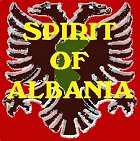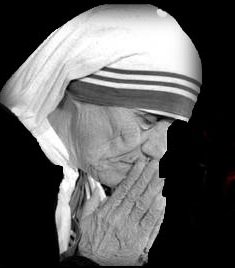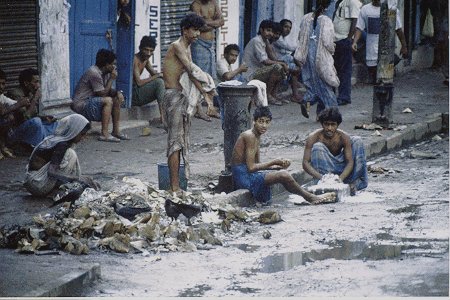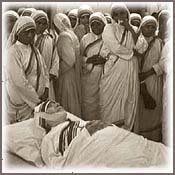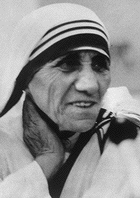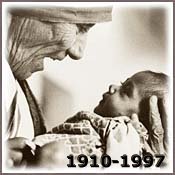|
Anthony Weir "Queen of the Mountains" Ivanaj brothers
King Zog Norman Wisdom and Albania
Skenderbeg Gazetteer
|
|
Agnes Gonxha Bojaxhi
Mother Teresa was born in Skopje in what is now The Former Yugoslav Republic of Macedonia on August 27, 1910. Her original name was Agnes Gonxha Bojaxhiu. Her father, who was of Albanian descent, ran a small farm. At the age of twelve, while attending a Roman Catholic elementary school, she records that she knew she had a vocation to help the poor. She decided to train for missionary work, and a few years later made India her choice. At the age of eighteen she left the parental home in Skopje and joined the Sisters of Loreto, an Irish community of nuns with a mission in Calcutta. After a few months' training in Dublin she was sent to India, where in 1928 she took her initial vows as a nun. From 1929 to 1948 Mother Teresa taught at St. Mary's High School in Calcutta, but the suffering and poverty she glimpsed outside the convent walls made such a deep impression on her that in 1946 she received permission from her superiors to leave the convent school and devote herself to working among the poor in the slums of Calcutta.
Although she had no funds, she started an open-air school for homeless children. Soon she was joined by voluntary helpers, and financial support was also forthcoming from various church organisations, as well as from the municipal authorities. This made it possible for her to extend the scope of her work, and on October 7, 1950, she received permission to start her own order "The Missionaries of Charity", whose primary task was to love and care for those persons nobody was prepared to look after. In 1979 she received the Nobel Peace Prize, "for work undertaken in the struggle to overcome poverty and distress, which also constitute a threat to peace." After being told of the honor, she replied, "I am unworthy." By this time her order had grown to 1,800 nuns and 120,000 lay workers, who operated nearly 200 centers and homes. She intervened between the warring factions in Beirut in 1982, and arranged a cease fire to rescue nearly 40 mentally ill children. Being prevented from visiting Albania by the communist regime, she visited several times during recent years. In 1988, she went to visit her mother's and sister's graves in Shkodra. Her last visit was in 1993, when on April 25th, she attended the inauguration ceremony of the Great Cathedral in Shkodra, alongside Pope John-Paul II. She visited Kosova in 1980. Eight of her charity houses operate in Albania and two in Kosova. The largest charity organization in Kosova carries her name. She was hospitalized several times in 1996 with heart, lung, kidney and other problems, and suffered ill health in earlier years. She indicated her intention to resign as head of her order in 1990, due to failing health. Because of disagreements on her successor, she remained as head of the order until March, 1996, when she stepped down and was replaced by Sister Nermala.
She died on September 5th, 1997, in Calcutta, India, after suffering cardiac arrest. She was 87. Her order currently has 4,000 nuns and novices, 400 priests and brothers and hundreds of thousands of volunteers, working at over 450 sites around the world. Teresa was recognized all over the world and she received many awards which can be listed in the following manner : 1962: The Magsaysay Award for International Understanding along with a cheque of 50,000 rupees. She used this award money to buy the Children's Home in Agra. In 1962, she also received India's second highest award the 'Padma Shri', from the President of India, Dr. Rajendra Prasad. In January 1971, Pope Paul VI presented her with a cheque worth £10,000 given by the Vatican as the first Pope John XXIII Peace Prize. She received the cheque and donated it for the construction of a leper colony in Madhya Pradesh on land donated by the Indian Government. On October 13, of the same year Joseph P. Kennedy Jr. Foundation presented her with an award in Washington. The award was made up of a heavy glass vase engraved with a figure of St. Raphael the Archangel and inscribed with the increasingly familiar words : "To Mother Teresa, whose struggles have shaped something beautiful for God."
In November, 1972, she was given the Nehru Award for international understanding by the Indian government. The Award consisted of a citation describing her as "one of the most impressive manifestations of charity throughout the world". It stated further that she had inspired a large number of devoted people all over the world to work with her in the service of the destitute, the uncared and helpless people of the society. In 1973, Mother Teresa was awarded the Templeton Prize for Progress in Religion, which made her the first recipient of this Prize. She was selected out of a total of two thousand nominations by a panel of judges representing the major religious traditions of the world, including Christianity, Judaism, Buddhism and Hinduism. In 1974, the Prime Minister of the Yemen Arab Republic presented her with a 'Sword of Honor'. In March, 1975, the United Nations Food and Agriculture Organization struck its Ceres Medals in recognition of Mother's "exemplary love and concern for the hungry and the poorest of the poor". The Medal showed Mother Teresa representing the Roman Goddess of Agriculture. In June, 1975, Mother Teresa was awarded the Voice of America's International Women's Year Pin for her work for the poor in India. On October 23, 1975, she became a recipient of one of the first Albert Schweitzer International Prizes, awarded at the University of North Carolina, Washington. On November 2, 1975,
she was awarded an honorary Doctor of Laws degree, at a special
ceremony at St. Francis Xavier University in Antigonish, Nova
Scotia. On March 3, 1976, Mrs. Indira Gandhi, as chancellor of the Vishwa Bharti University, conferred on Mother Teresa the University's highest honor, 'The Deshikottama' (Doctor of Literature) scarf in recognition of her significant contribution to the cause of human suffering. Mrs. Gandhi commented on her, "She is tiny to look at, but there is nothing small about her." In June, 1977, She was awarded an honorary Doctorate of Divinity from the University of Cambridge. On October 17, 1979, she was awarded the Nobel Peace Prize with a cheque for $130,000. On December 8, 1979, Mother Teresa landed at Oslo's international airport accompanied by Sister Agnes and Sister Gertrude. She had politely refused the heavy coats and fur-lined boots to protect against a temperature of minus ten degrees Celsius offered her by the Nobel committee. She requested cancellation of the celebratory banquet and said that the money should be used for those who were really in need of a meal. Thus, the $4,000 that was to be spent for the banquet and further $50,000 raised by Norwegian young people were added to her prize money. More than one thousand people welcomed her. She was given a reception the moment she landed at Oslo, by the Indian Ambassador in Norway. She was grateful for the prize as it would provide housing for the homeless and for leper families. Moreover, she was specially grateful for the "gift of recognition of the poorest of the poor of the world". On December 10, 1979, in the presence of King Olaf V of Norway, Crown Prince Harald, Crown Princess Sonja, and many other dignitaries, Mother Teresa accepted the gold medal and the money, as she had accepted all other honors, 'unworthily' but "gratefully in the name of poor, the hungry, the sick and the lonely".
She was further honored by the Indian Government in 1980, as she became one of the only three Indian nationals ever to receive a Nobel Prize. She was also one of the only three Indians ever to have been honored with an official reception within the ramparts of Delhi's historic Red Fort. The other two recipients were Jawarlahal Nehru and his daughter Indira Gandhi. In the Rashtrapati Bhavan, the Presidential Palace in New Delhi, the President of India, Neelam Sanjiva Reddy, gave her India's highest civilian award, the 'Bharat Ratna' or 'Jewel of India'. In the same year she was awarded the gold medal of the official Soviet Peace Committee. On November 24, 1983, Mother Teresa was presented with the insignia of the Honorary Order of Merit, by Queen Elizabeth II at the Presidential Palace in Delhi. On June 20, 1985, at the White House in Washington, the then U.S. President, Ronald Reagan presented her with the United States Presidential Medal of Freedom, calling her a 'heroine of our times'. He declared that "the goodness in some hearts transcends all borders and all narrow nationalistic considerations". On October 27 of the same year, she was honored at the National Shrine of the Immaculate Conception in Washington, when Cardinal O'Boyle, Chairman of the Shrine's Committee, presented her with a monetary gift on behalf of the thousand of visitors to the Shrine. On July, 1987, the film 'Mother Teresa' made by two American sisters, Ann and Jeanette Petric, was awarded the Soviet Peace Committee Prize during the 15th International Film Festival held in Moscow. On March 28, Yasser Arafat, President of the Palestine Liberation organization, presented her with a cheque of US $50,000. He invited her to the Holy Land and asked her to open 'Death with Dignity' homes in Bethlehem and Jerusalem. In August, 1992, in New York, she received the Knights of St. Columbanus' Gaudium et Spes (Hope and Joy) Award from Cardinal John O' Connor. On August, 1992, she was awarded with an honorary fellowship of the Royal College of Surgeons in Ireland. On December, 1992, in Kolkata, she received the United Nations cultural agency's peace education award to "crown a life consecrated to the service of the poor, to the promotion of peace and to combating injustice". She was presented a cheque of £ 50,000 by the UNESCO director general. The money was used by her to set up a home for the handicapped near Kolkata. In the same year, the communist President of Albania, Mr. Ramiz Alia, awarded Albanian citizenship to Mother Teresa, who had once been forced to take a sad decision of not visiting her dying mother in her homeland as she wanted to serve the poor of the world. Mr. Alia also created a 'Mother Teresa Prize' to be awarded to those who distinguished themselves in the field of humanitarian and charitable work.
In January, 1993, she received the papal award 'Pro Ecclesia et Pontifice'. In October, 1994, she received the 'U Thant Peace Award' for her 'Tireless Service to humanity'. On May 16, 1997, she was awarded a United States Congressional gold medal in recognition of her "outstanding and enduring contributions to humanitarian and charitable activities.
Visit: Mother Teresa Official Web Site http://www.tisv.be/mt/indmt.htm
|
